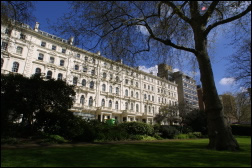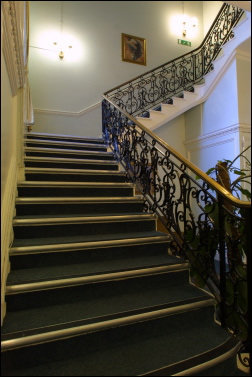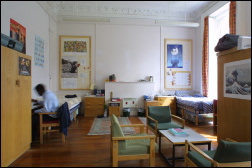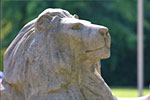João T Cabral
(Present Warden of Garden and Weeks Halls)
The fascinating history of the building and its occupiers at Garden and Weeks Halls is given by its present Warden, Dr João Cabral.
 2007 is Imperial’s Centenary but also a special year for us at Garden and Weeks halls (G&W): Garden Hall celebrates its 50th anniversary as a hall of residence! (Weeks Hall’s golden jubilee will follow in just a couple of years).
2007 is Imperial’s Centenary but also a special year for us at Garden and Weeks halls (G&W): Garden Hall celebrates its 50th anniversary as a hall of residence! (Weeks Hall’s golden jubilee will follow in just a couple of years).
Garden Hall is well known: a row of Victorian houses on the North Side of Prince’s Gardens, between Sports Centre and Weeks Hall. Both Garden and Weeks Halls are grade II listed buildings. There is a fascinating history behind G&W halls, which dates back to the Great Exhibition in 1851 and involves illustrious residents as Sir Henry Singer Keating, Solicitor-General in two of Palmerston's administrations and first tenant of house 11, Lord Blackburn (1861-1887), Sir William Earle and Sir William Drake (until 1891), or Rt. Hon. Lord Walter Gordon-Lennox, PC (until 1921).
 Garden Hall’s Victorian houses were completed in 1860, adjacent to the Great Exhibition site. The developer was Sir Charles Freake and John Johnson was the probable architect (apparently he is well-known for mid-Victorian buildings in London). At the time, these houses were an “affordable” option to Belgravia or Mayfair, for professionals and minor noble families. Yes “affordable”, but they still needed accommodation for several family members, a few guest bedrooms and two or three elegant rooms for entertaining guests; and of course rooms for a dozen or so servants, usually on the top floor; and finally a service area with kitchen, wine cellar, coal cellar, laundry, servants' eating room etc, in the basement!
Garden Hall’s Victorian houses were completed in 1860, adjacent to the Great Exhibition site. The developer was Sir Charles Freake and John Johnson was the probable architect (apparently he is well-known for mid-Victorian buildings in London). At the time, these houses were an “affordable” option to Belgravia or Mayfair, for professionals and minor noble families. Yes “affordable”, but they still needed accommodation for several family members, a few guest bedrooms and two or three elegant rooms for entertaining guests; and of course rooms for a dozen or so servants, usually on the top floor; and finally a service area with kitchen, wine cellar, coal cellar, laundry, servants' eating room etc, in the basement!
 In more recent times, during World War II, the houses were requisitioned by the government and used by the Admiralty and, by the late 1940s, passed to the hands of the London Hostels Association. It seems that houses 8-15 Prince's Gardens were offered to the College for student accommodation as part of a bid (led by Sir John Betjeman, poet and founder of Victorian Society) to keep Colcutt Tower – now Queen's Tower – in the early 50s. Imperial and Garden Hall soon after played a role during the Hungarian Uprising in 1956 by welcoming exiled students in house 12.
In more recent times, during World War II, the houses were requisitioned by the government and used by the Admiralty and, by the late 1940s, passed to the hands of the London Hostels Association. It seems that houses 8-15 Prince's Gardens were offered to the College for student accommodation as part of a bid (led by Sir John Betjeman, poet and founder of Victorian Society) to keep Colcutt Tower – now Queen's Tower – in the early 50s. Imperial and Garden Hall soon after played a role during the Hungarian Uprising in 1956 by welcoming exiled students in house 12.
Garden Hall was formally inaugurated in 1957 and, that year, the College Governing Body minutes would justify “There is (…) a general agreement that the full University training is not obtainable unless the student spends at least a part of his career in residence. (…) the need for increased residential accommodation was ‘reinforced by the presence in the Universities of increased numbers of students who come from homes with little or no tradition of culture and whose undergraduate lives would be greatly enriched by a period of residence in Hall.’”!
 Every year, Garden Hall becomes the home of 82 Imperial freshers in single, double and triple rooms, who enjoy its impeccable common room, previously the oak-panelled study of Sir Henry Keating looking onto the garden. The senior reapp (hall senior) has the honour of occupying the Gothic guest room, set up for Lady Elizabeth Vernon in the 30s, but all bedrooms are unique: room 5, for example, was the drawing room of Sir William Drake!
Every year, Garden Hall becomes the home of 82 Imperial freshers in single, double and triple rooms, who enjoy its impeccable common room, previously the oak-panelled study of Sir Henry Keating looking onto the garden. The senior reapp (hall senior) has the honour of occupying the Gothic guest room, set up for Lady Elizabeth Vernon in the 30s, but all bedrooms are unique: room 5, for example, was the drawing room of Sir William Drake!
 You may wonder: “what are students doing in Victorian houses in South Kensington?“ I would argue that was the very purpose of Prince Albert! You see, Prince Albert, as president of the Royal Commission for the Great Exhibition (and using the £186k profit of the exhibition!) decided to establish the site as an “educational and cultural centre” for London. I just hope we live up to the expectations…
You may wonder: “what are students doing in Victorian houses in South Kensington?“ I would argue that was the very purpose of Prince Albert! You see, Prince Albert, as president of the Royal Commission for the Great Exhibition (and using the £186k profit of the exhibition!) decided to establish the site as an “educational and cultural centre” for London. I just hope we live up to the expectations…
João T. Cabral,
Warden of Garden and Weeks Halls
© 2007 Imperial College London

Through the first decade of the twenty-first century the campaign seeks to philanthropically raise £207 million from Imperial’s alumni, staff and friends, and donations from charitable foundations and industry.
Where your support can make a differenceGive now

Imperial’s Centenary Year provides an opportunity to recognise and celebrate members of the Imperial community.
View staff and student portraits
